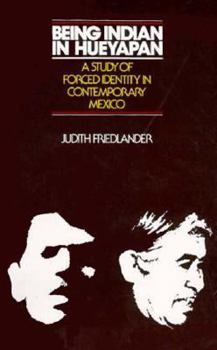Being Indian in Hueyapan: A Study of Forced Identity in Comtemporary Mexico
Select Format
Select Condition 
Book Overview
Being Indian in Hueyapan: A Study of Forced Identity in Contemporary Mexico This description may be from another edition of this product.
Format:Paperback
Language:English
ISBN:0312073151
ISBN13:9780312073152
Release Date:January 1975
Publisher:St. Martin's Press
Length:205 Pages
Weight:0.60 lbs.
Dimensions:0.6" x 5.5" x 8.3"
Customer Reviews
1 rating
Investigating Negative Identity in Mexico
Published by Thriftbooks.com User , 20 years ago
Bantamweights can duck and jab, they can throw a few good punches too. It's not only the heavyweights of this world who can score points. Myself, I prefer reading anthropology books to watching boxing matches, but the analogy still holds. As far as I know, Judith Friedlander is an anthropology professor in New York who never wrote any more books on Mexico. Yet she packs a lot of punch in BEING INDIAN IN HUEYAPAN. Her basic premise is concise. "To be Indian in Hueyapan [a small mountain village in the state of Morelos in Mexico] is to have a primarily negative identity. Indian-ness is more a measure of what the villagers are not or do not have vis-à-vis the Hispanic elite than it is of what they are or have." The culture of the people living in this village had changed a lot over the 400 years till the early 1970s, but as she says, "the cultural relationship of Indian to Hispanic remained the same." First the church, then the Spanish colonizers and rulers, and then the independent Mexican government and its ruling class defined Indians as being outside of normal, mestizo society. Over the centuries, governing elites have forced so much change on the Indian societies in Mexico that almost nothing remains of pre-Hispanic culture. Certain aspects of "Indian" society that are held up today as evidence of cultural survivals are actually proof of earlier Hispanic influence that has died out in the mainstream society. Friedlander points out that the Mexican government since the Revolution of 1910-1920 has tried to incorporate the Indian communities into wider Mexican society and, at the same time, tried to maintain their so-called Indian identity and their accompanying low socio-economic position. An image of "Indian Mexico" is manufactured for tourists, for national image making, and to cover up the fact that many people remain at the margins of society. The author finds that tradition says that two peoples occupy modern Mexico---Indians and mestizos-but that the distinction is a false one. BEING INDIAN IN HUEYAPAN is well-written and centers around a very clear, definable argument. I would not hesitate to recommend it to anyone teaching undergraduate courses in Anthropology or Latin American studies. It could also be useful for anyone interested in native American peoples' fate in the 20th century. The photographs are fine and there is no use of baffling jargon. However, I would say that there are 3 points to consider---they could form the basis of many a discussion. 1) Friedlander does not refer to any works on ethnic identity or on how groups identify themselves. Culture changes constantly. To say that the Mexican Indians are now not much like their ancient ancestors or are pretty much like other Mexicans is not proof that they have ceased to exist. The Hueyapan villagers spoke Nahuatl. In European tradition, speaking another language more or less guarantees that you will be seen as belonging to "another ethnic group", no mat





